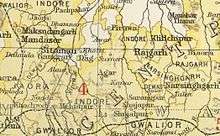Dewas State
Dewas State was a territory within Central India, which was the seat of two Maratha princely states during the British Raj. After the Maratha conquest of Central India, Dewas was divided into two states - Dewas Junior ruled by Jivaji Rao ('Dada Saheb') Puar and Dewas Senior ruled by Tukoji Rao ('Baba Saheb') Puar. On 12 December 1818, the 2 Dewas States became British protectorates.
| Dewas State (Junior Branch) देवास रियासत | |||||||||
|---|---|---|---|---|---|---|---|---|---|
| Parmar Puar Maratha Rajput Princely State of British India | |||||||||
| 1728–1948 | |||||||||
 Flag | |||||||||
 Dewas Senior and Dewas Junior states in the Imperial Gazetteer of India | |||||||||
| Area | |||||||||
• 1901 | 1,100 km2 (420 sq mi) | ||||||||
| Population | |||||||||
• 1901 | 54904 | ||||||||
| History | |||||||||
• Established | 1728 | ||||||||
• Independence of India | 1948 | ||||||||
| |||||||||
| Today part of | India | ||||||||
| Dewas State (Senior Branch) देवास रियासत | |||||||||
|---|---|---|---|---|---|---|---|---|---|
| Parmar Puar Maratha Rajput Princely State of British India | |||||||||
| 1728–1948 | |||||||||
 Flag | |||||||||
| Area | |||||||||
• 1901 | 1,160 km2 (450 sq mi) | ||||||||
| Population | |||||||||
• 1901 | 62312 | ||||||||
| History | |||||||||
• Established | 1728 | ||||||||
• Independence of India | 1948 | ||||||||
| |||||||||
| Today part of | India | ||||||||
History
Foundation and being part of Maratha confederacy
The seats were established in 1728 by two brothers from the Maratha clan Puar, who advanced into Malwa with the Peshwa Baji Rao, and divided the territory among themselves after the Maratha conquest.[1] Their descendants ruled as the senior and junior branches of the family.
Princely states under British rule
After 1841, each branch ruled his own portion as a separate state, though the lands belonging to each were intimately entangled; in Dewas, the capital town, the two sides of the main street were under different administrations and had different arrangements for water supply and lighting.
The two Rajas heading Dewas states both lived in separate residences in the town of Dewas, and ruled over separate areas.[2]
The Junior branch had an area of 440 sq mi (1,100 km2) and had a population of 54,904 in 1901, while the Senior branch had an area of 446 sq mi (1,160 km2) and a population of in 62,312 in the same year.[3] Both Dewas states were in the Malwa Agency of the Central India Agency.
Dewas Junior & Senior Darbars (Court) composed of Jagirdars, Sardars, Istamuradars and Mankaris.[4][5]
Accession to Indian Union
After India's independence in 1947, the Maharajas of Dewas acceded to India, and their states were integrated into Madhya Bharat, which became a state of India in 1950. In 1956, Madhya Bharat was merged into Madhya Pradesh state.
References
- Mayer, Adrian C. (1960). Caste and Kinship in Central India: A Village and Its Region: International library of sociology and social reconstruction. University of California Press. p. 13. ISBN 9780520017474. Retrieved 8 September 2012.
- Lethbridge, Sir Roper (1893). The golden book of India: a genealogical and biographical dictionary of the ruling princes, chiefs, nobles, and other personages, titled or decorated, of the Indian empire. Macmillan. p. 116. Retrieved 8 September 2012.
-

- Madan, T.N. (1988). Way of Life: King, Householder, Renouncer : Essays in Honour of Louis Dumont. Motilal Banarsidass. p. 129. ISBN 9788120805279. Retrieved 4 July 2015.
- Russell, Robert Vane (1916). "Pt. II. Descriptive articles on the principal castes and tribes of the Central Provinces".